
Tarucus nara, the striped Pierrot, is a small butterfly found in Sri Lanka and south India that belongs to the lycaenids or blues family.
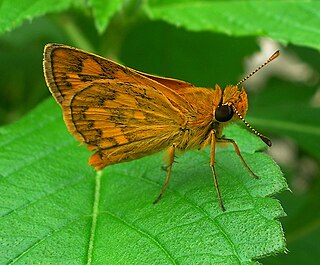
Potanthus is a large genus of skipper butterflies. They are commonly known as darts. They are found from South Asia to East Asia, and down to maritime Southeast Asia. It includes about 35 species, all of which look very similar to each other and are often only reliably identifiable through the examination of the male genitalia.
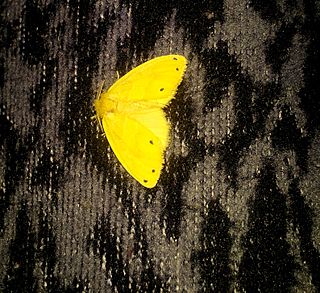
Artaxa is a genus of tussock moths in the family Erebidae erected by Francis Walker in 1855. Some of the species have urticating hairs.

Laelia is a genus of tussock moths in the family Erebidae. The genus was described by Stephens in 1828. Species are well distributed throughout Europe, Japan, China, India, Sri Lanka, Myanmar and Java.
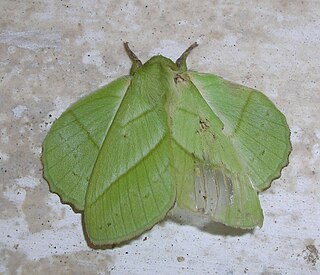
Trabala is a genus of moths in the family Lasiocampidae described by Francis Walker in 1856. The species are confined to China, throughout India, Sri Lanka, Myanmar and Java.
Ancylolomia chrysographellus, the angled grass moth, is a species of moth in the family Crambidae. It is found on Cyprus and in Kenya, Uganda, Yemen, India, Pakistan, Sri Lanka, Myanmar, China, Korea, Japan, Taiwan, the Philippines and Indonesia.
Artaxa vitellina is a moth of the family Erebidae first described by Vincenz Kollar in 1848. It is found in India and Sri Lanka.
Sphrageidus xanthorrhoea is a moth of the family Erebidae first described by Vincenz Kollar in 1848. It is found in India, Sri Lanka, Java and Indonesia. It was once classified under the genus Euproctis, where it is accepted by some authors.
Laelia cardinalis is a moth of the family Erebidae first described by George Hampson in 1893. It is found in Sri Lanka.
Laelia fasciata is a moth of the family Erebidae first described by Moore in 1883. It is found in Sri Lanka, India and Myanmar. One subspecies is recognized, Laelia fasciata rubripennisMoore, 1884.
Laelia suffusa is a moth of the family Erebidae first described by George Hampson in 1893. It is found in Bangladesh, Sri Lanka, Java, East Indies, Sundaland, the Philippines and Sulawesi.
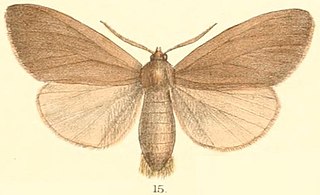
Laelia testacea is a moth of the family Erebidae first described by Francis Walker in 1855. It is found in India and Sri Lanka.

Amblychia angeronaria is a moth of the family Geometridae first described by Achille Guenée in 1858. It is found in Sri Lanka, northern India, Korea, Andaman Islands to Taiwan, Borneo, Sumatra, Korea Japan and Australia.

Celenna festivaria is a moth of the family Geometridae first described by Johan Christian Fabricius in 1794. It is found in India, Sri Lanka, Myanmar, Borneo, Java Taiwan, the Ryukyu Islands and Luzon in the Philippines.
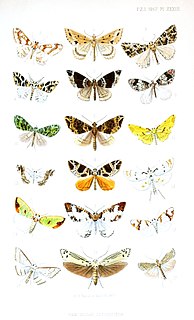
Corymica specularia is a moth of the family Geometridae first described by Moore in 1867. It is found in Sri Lanka, India and Taiwan.
Derambila saponaria is a moth of the family Geometridae first described by Achille Guenée in 1858. It is found in Sri Lanka, India, Sumatra and Borneo.
Entomopteryx combusta is a moth of the family Geometridae first described by Warren in 1893. It is found in Sikkim in India, Sri Lanka, Java, Taiwan, and Japan.
Eucyclodes divapala is a moth of the family Geometridae first described by Francis Walker in 1861. It is found in Sri Lanka, as well as Taiwan.
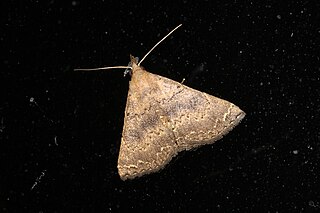
Progonia oileusalis is a moth of the family Noctuidae first described by Francis Walker in 1859. It is found in Sri Lanka, Borneo, India, Taiwan, Japan and the Philippines.
Trachea melanospila is a moth of the family Noctuidae first described by Vincenz Kollar in 1844. It is found in Sri Lanka, Korea, Japan and Siberia.









